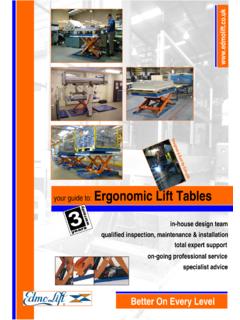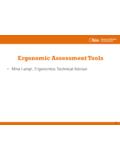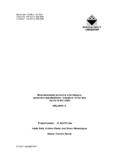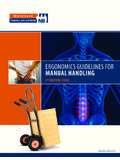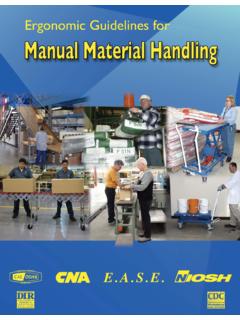Transcription of Risk assessment of manual handling involving …
1 Prepared by the Health and Safety Laboratory for the Health and Safety Executive 2011 Health and Safety ExecutiveRisk assessment of manual handling involving variable loads and/or variable frequenciesLiterature review and proposed V-MAC assessment tool RR838 Research ReportDr Andrew DJ Pinder Health and Safety LaboratoryHarpur HillBuxtonDerbyshireSK17 9 JNThe objectives of this study were to carry out a literature review of issues related to load and frequency in manual handling , and in the light of the findings to develop a method of risk assessment that could be applied to jobs, such as order picking, where either the load or frequency of handling are very variable.
2 It is widely assumed that variation in manual work is beneficial for workers, but little evidence was found to support or refute this. Assessing variable manual handling is inherently difficult and existing methods concentrate on single constant tasks. Cumulative mass limits exist in various national guidelines and an international standard but are inconsistent. Use of such a mass limit independent of frequency of handling is contrary to evidence that the amount that can be handled increases with the frequency of handling . The proposed V-MAC (variable MAC) uses the traffic-light approach of the MAC to consider the load-frequency distribution of the objects that an individual handles during a shift.
3 A draft MS Excel workbook has been developed to implement it. It should be tested for usability by inspectors of health and safety and duty-holders familiar with carrying out risk assessments of manual report and the work it describes were funded by the Health and Safety Executive (HSE). Its contents, including any opinions and/or conclusions expressed, are those of the author alone and do not necessarily reflect HSE assessment of manual handling involving variable loads and/or variable frequenciesLiterature review and proposed V-MAC assessment tool HSE BooksHealth and Safety Executive Crown copyright 2011 First published 2011 All rights reserved.
4 No part of this publication may be reproduced, stored in a retrieval system, or transmitted in any form or by any means (electronic, mechanical, photocopying, recording or otherwise) without the prior written permission of the copyright for reproduction should be made in writing to:Licensing Division, Her Majesty s Stationery Office,St Clements House, 2-16 Colegate, Norwich NR3 1 BQor by e-mail to CONTENTS 1. Problem Approach Structure of the 2. Summary of the previous review and laboratory Search strategy for the literature 3. Benefits of variability in manual Limits on maximum daily Exposure variation Updated literature Muscle physiology and variable manual Recommended 4.
5 THE V-MAC: A METHOD OF ASSESSING manual handling JOBS WITH VARIABLE LOADS OR FREQUENCY OF Stages of Explanation of colour zone APPENDIX 1 BENEFITS OF VARIABILITY IN manual handling APPENDIX 2 RELEVANCE OF GUIDANCE AND STANDARDS DOCUMENTS TO THE assessment OF VARIABILITY IN manual HANDLING22 A UK, Australian and North American guidance A International and European A French guidance A Danish A Summary regarding standards and guidance APPENDIX 3 METHODOLOGICAL ISSUES REGARDING assessment OF VARIABLE A Difficulties in assessing variable manual A Basic epidemiological exposure A Measurement of exposure A Dose A Dealing with variability of A Summary regarding methodological APPENDIX 4 REVIEW OF ADDITIONAL STUDIES OF A Effect of A Long duration repetitive A Effect of varying load and frequency on metabolic A Effect of task variation on metabolic A Maximum Acceptable
6 Frequency/Minimum Acceptable handling Time A Interaction of load and iii APPENDIX 5 REVIEW OF ADDITIONAL STUDIES OF A Maximum acceptable weight of A One-handed/two-handed combined A Physiological A Combined handling A Effect of carrying distance and pouring height on APPENDIX 6 REVIEW OF ADDITIONAL STUDIES OF OTHER manual handling A Pushing and pulling A Work pace, breaks and duration in upper limb A Maximum acceptable frequencies for hand grip A Acceptable frequencies of exertion as a percentage of sampling A Effect of additional physical load on acceptable A Effect of a weight-lifting belt on A Perception of box A Injury occurrence and fitness in high-frequency manual A manual hose A Muscle activity during seated A Effect of variable load in seated A Pinching A Wrist A Effect of hand impact A Grip type for insertion APPENDIX 7 MODELLING OF RELATIONSHIPS BETWEEN FREQUENCY OF handling AND A A A A Application of the predictive
7 APPENDIX 8 LIST OF APPENDIX 9 APPENDIX 10 LIST OF TABLES Table 1 Common summary measures of exposure (after Kriebel et al., 2007)..26 Table 2 Exposure concepts for ergonomic Table 3 Methods of aggregating multiple tasks (after Dempsey, 1999)..31 Table 4 Simple lifting Table 5 Simple carry no lifting/lowering, no unloaded Table 6 Push trolley, walk back Table 7 Combined lift, carry, lower, walk Table 8 Correction coefficients for age and Table 9 Correction coefficients for distance of Table 10 Correction coefficients for task iv Table 11 MAWLs (kg) determined for males at different Table 12 MAWLs (kg) determined for females at different Table 13 MAWLs determined for males relative to MAWL at 1 lift per Table 14 MAWLs determined for females relative to MAWL at 1 lift per Table 15 handling rates (kg per minute)
8 For male MAWLs at different Table 16 handling rates (kg per minute) for female MAWLs at different frequencies (lifts per minute)..60 Table 17 Male handling rates relative to the male handling rate at 1 lift per Table 18 Female handling rates relative to the female handling rate at 1 lift per Table 19 Best-fit predictive equations for psychophysical LIST OF FIGURES Figure 1 Proposed Lifts per shift/load weight graph for lifting Figure 2 Possible load/frequency distribution for a variable Figure 3 Weight distribution with a 15 kg upper Figure 4 Possible even weight Figure 5 Actual distribution of weights from a baggage handling task plotted using the draft Excel Figure 6 Colour code and values of summary bars in the draft Excel workbook for a
9 Baggage handling Figure 7 V-MAC levels of risk in the draft Excel Figure 8 Regression graph for predicting male MAWL from frequency of Figure 9 Regression graph for predicting female MAWL from frequency of Figure 10 Regression graph for predicting male MAWL relative to MAWL at one lift per Figure 11 Regression graph for predicting female MAWL relative to MAWL at one lift per Figure 12 Regression graph for predicting male handling rate in kg/min from frequency of Figure 13 Regression graph for predicting female handling rate in kg/min from frequency of Figure 14 Regression graph for predicting male handling rate relative to handling rate at one lift per Figure 15 Regression graph for predicting male handling rate relative to handling rate at one lift per vvi EXECUTIVE SUMMARY This work arose from a request from Local Authority Inspectors of Health and Safety who had attempted to use the manual handling assessment Charts (MAC) to assess the risk factors for musculoskeletal disorders in order picking activities in warehouses.
10 They experienced difficulties using the load/frequency graph in the Lifting chart because of the very great variability in loads and frequencies of handling in such jobs. The manual handling Operations Regulations (as amended) 1992 and associated HSE guidance list frequency of handling and the weight handled as among factors to be considered in risk assessments but do not address handling where the load or frequency are very variable. The MAC aids assessments of the most common risk factors in lifting, carrying and team handling operations. It was not intended to cover jobs where an individual can handle objects of many different weights over the course of a shift.










